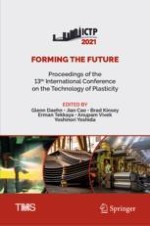2021 | Buch
Forming the Future
Proceedings of the 13th International Conference on the Technology of Plasticity
herausgegeben von: Glenn Daehn, Jian Cao, Prof. Dr. Brad Kinsey, Prof. Dr. Erman Tekkaya, Anupam Vivek, Dr. Yoshinori Yoshida
Verlag: Springer International Publishing
Buchreihe : The Minerals, Metals & Materials Series
